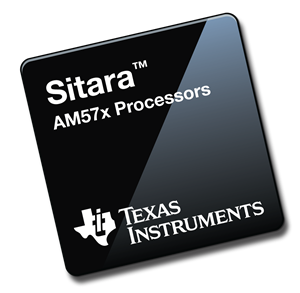SSZTC22 april 2018 AM5706 , AM5708 , AM5716 , AM5718 , AM5726 , AM5728 , AM5746 , AM5748
As the embedded world continues to expand, applications are getting increasingly complex. With this, the demand for a specific processor core geared towards specific tasks is quickly rising. We no longer live in a world where one high-performance, single architecture processor is king. The idea of implementing a variety of cores in a single processor is starting to gain traction, and we are beginning to see the most complex applications on the planet be computed on a single processor.

TI recently released the new Sitara™ AM57x family of processors, which were designed to tailor to the embedded industry’s specific needs of a processor that can meet a variety of performance requirements, while staying flexible enough to serve a wide array of applications. Equipped with up to two ARM® Cortex®-A15 cores, four C66x DSP cores, video/graphic accelerators, quad core programmable real-time unit (PRU), and two ARM Cortex-M4 cores, the Sitara AM57x processors are ideal for embedded applications that require more than just single core performance. The all-in-one processor gives flexibility a whole new meaning. Rather than having more or less of the same core, the AM57x processors give designers the ability to choose from a variety of cores. Whether the task requires real-time control, high-performance number crunching, video streaming, or communication to a unique industry specific protocol, the AM57x processors have a core to fulfill each need. Here’s a breakdown of some of the cores featured on our new device family:
The ARM Cortex-A15 core has exploded in popularity in many industries due to its high performance and networking specific capabilities. Whether a designer wants to use a single or dual core, the Cortex-A15 is the engine that drives the Sitara AM57x processors.
The ARM Cortex-M4 core is ideal for real-time control and processing tasks. This core comes in handy where there is anything from motor control to sensor monitoring.
The programmable real-time unit (PRU) is optimized for a variety of industrial communication protocols without taking away resources from the rest of the processor, and often times replacing external FPGAs or ASICs used for implementing those protocols. The quad-core PRU can also be used for deterministic, low-latency, real-time control responsibilities.
The C66x DSPs are essential for any high-performance data crunching tasks such as analytics for machine vision, software defined radio (SDR), high performance math computing, and biometric identification. The engineer has the option to choose between a single or dual core C66x DSP while selecting the right Sitara AM57x processor for their application.
With the option of integrated video and graphic accelerators, engineers have the ability to effortlessly incorporate 1080p video and 2D or 3D graphical interfaces to any embedded application.

The AM57x processors are changing the world of embedded processing, combining more performance with unrivaled integration, scalability and peripherals. Over the course of the next few weeks, we will be looking into specific applications that the AM57x processors are a fit for. Be sure to check back next week as we discuss particular networking and cloud applications that the AM57x processors are best suited for.
Do you have any design ideas of what you will be using the Sitara AM57x processors for?